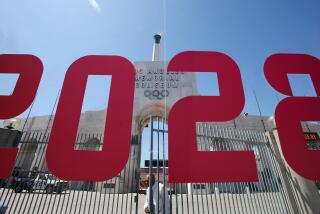Expo Line to begin running test trains to Westside
After numerous delays and cost increases, officials this week will begin running test trains on the long-awaited Expo Line and have announced that the first rail line into the traffic-clogged Westside since the days of the Red Car trolleys could start operations in November.
The first phase of the project, when completed, promises to zip commuters about 8.6 miles from downtown to Culver City in 30 minutes. Originally carrying a price tag of $640 million, the cost has now reached $930.6 million. The entire first phase of the line will go into downtown Culver City near the Kirk Douglas Theatre, but officials say they will only be able to open the line as far as La Cienega Boulevard, just east of Culver City, in the fall, with a target opening date of Nov. 15. They hope to finish the last 0.7 miles early in 2012.
The planned opening of the line has generated great excitement in transportation circles because the Expo Line will move L.A.’s rail network far into the western part of the county. But it remains unclear how popular the line — which will eventually extend all the way to Santa Monica — will actually be.
The agency tasked with building the line has not released any ridership projections for the next nine years. But officials estimate that there will be an average of 64,000 weekday boardings from downtown to Santa Monica by 2030, and that there will be an average of 27,000 weekday boardings from downtown to Culver City by 2020.
Some of Metro’s rail lines have not produced the ridership numbers officials had hoped for, and it’s unclear how many commuters will opt to get out of their cars. Many east-west commuters may still be waiting for a proposed subway line that runs down Wilshire Boulevard.
Still, Expo backers are eager to see how the line does.
“From a line that had every sort of challenge for close to 10 years, it’s absolutely amazing that it’s coming to fruition,” said Bart Reed, executive director of the nonprofit Transit Coalition. “Going anywhere to West L.A. or Culver City is a long, slow, tedious trip, and having the choice to be on a train and have a predictable schedule changes the whole dynamics of going in either direction. It’s a game-changer in terms of choice.”
Construction crews last week poured concrete and used cranes to lift staircases at some of the line’s stations. Traffic was rerouted and lanes were closed in some areas as bulldozers and dump trucks carried materials.
There was already graffiti on some of the walls along the line, a contrast to multicolored murals painted by students at the Foshay Learning Center that depicted trains juxtaposed with cars. Along a stretch near Exposition Park and USC, crews planted ginkgo trees.
Officials see the Expo Line as a spoke in a wheel of rail lines that need to be built to provide Angelenos with better transit access and options for commuting.
Rick Thorpe, who is heading the authority in charge of building the Expo Line, believes that rail projects are essential to the city’s future.
“The freeway can’t take any more. You’re now seeing spillover onto city streets. Pretty soon those city streets are going to get so clogged.... and you can’t add any more freeways; freeways have become cost prohibitive,” Thorpe said. “Rail is about the only alternative that we’ve got left.”
When the Expo Line was conceived, it was considered a low-cost option for getting rail service into the Westside. It is several miles south of key Westside locations such as Beverly Hills, Century City and Westwood, and runs partially along existing freight tracks. But costs rose because of design enhancements, safety concerns and increases in construction prices. Some officials attributed problems to an initial bewilderment about funding sources and a process that broke up construction, design, and other contracts into too many pieces.
Delays occurred because the construction authority had to relocate its maintenance facility; there was a struggle to gain safety approval where the line crosses Farmdale Avenue near Dorsey High School; and safety improvements were needed at the intersection of the Expo and Blue lines, among other issues.
Officials hope phase two from Culver City to Santa Monica will not be so problematic.
The Expo Line could also gain more passengers once the Crenshaw Line, which will run from the Expo Line to the Green Line through South L.A. and Inglewood, is built.
More to Read
Start your day right
Sign up for Essential California for news, features and recommendations from the L.A. Times and beyond in your inbox six days a week.
You may occasionally receive promotional content from the Los Angeles Times.






